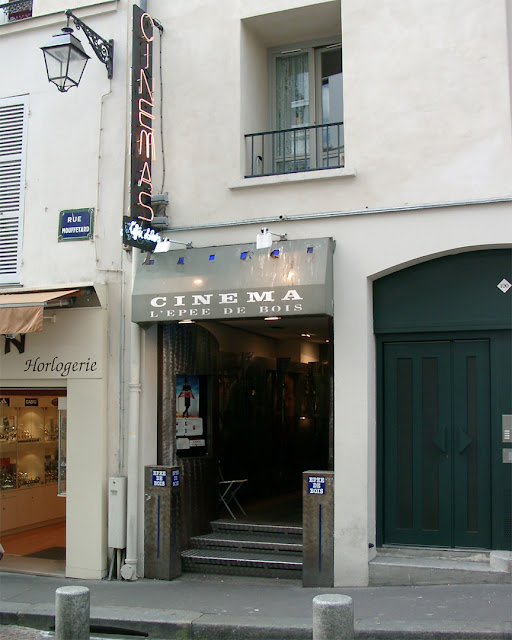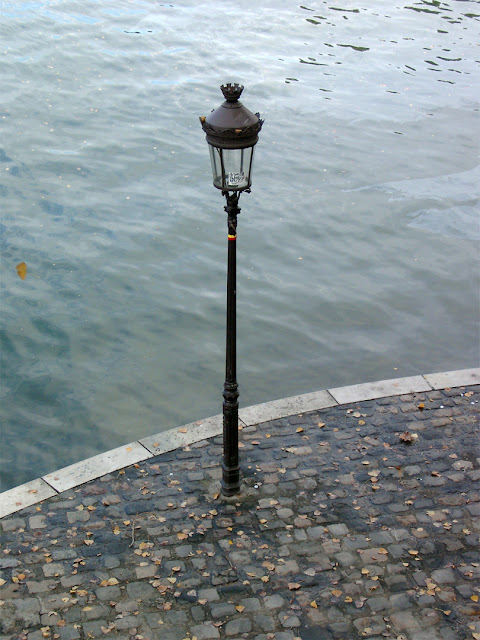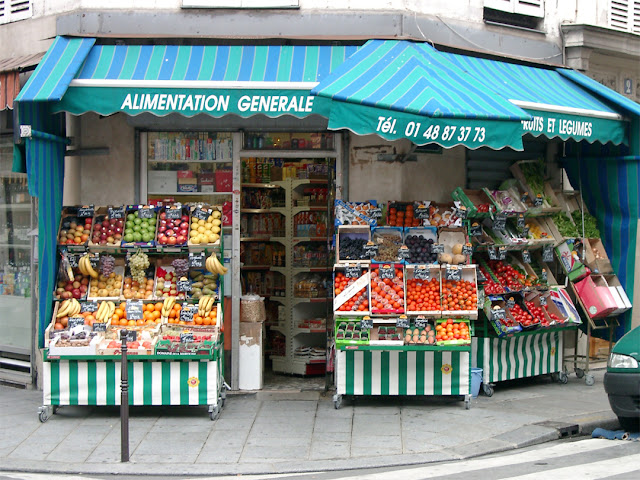Sunday, December 31, 2006
Colors
Le Moretti by Raymond Moretti, 1992
Courbevoie, La Défense
Paris, October 2005
“Moretti's vivid imagination was able to express itself freely, transforming a 32-metre air vent into an unusual, colourful artwork. Using 672 fibreglass tubes from 2 to 30 centimetres in diameter, painted in 19 different colours, he covered the entire surface to better underline the volume while maintaining a verticality, offering an insolent and joyful dynamic. In total, the tubes are 22 kilometres long and weigh 27.5 tons! The artwork was created in 1990. The tubes were transported by barge from the manufacturing plant to the location of the chimney and required a total of 2,100 hours of assembly time. It was inaugurated in 1995.” (Le Moretti, Paris La Défense)
Saturday, December 30, 2006
Oiseau mécanique
Oiseau mécanique (Mechanical Bird) by Philolaos Tloupas, 1972
Place des Reflets
Courbevoie, La Défense
Paris, October 2005
“An emblematic sculpture in the artist's artwork, the Oiseau mécanique, with its surprising aspects, seems to have come straight out of his imagination. Its stainless steel structure allows a play of reflections with the sky, and oscillates between urban aesthetics and natural forms. Philolaos presents two other artworks at La Défense: Nymphéas and Cheminées.” (Oiseau mécanique, Paris La Défense)
Friday, December 29, 2006
Tour Opus 12
Tour Opus 12 by Denis Valode and Jean Pistre
Esplanade du Général-de-Gaulle
Puteaux, La Défense
Paris, October 2005
Thursday, December 28, 2006
Wednesday, December 27, 2006
Araignée Rouge
Araignée Rouge (Red Spider) by Alexander Calder, 1974
Place de La Défense
Puteaux, La Défense
Paris, October 2005
“This imposing sculpture (stable in the words of its author, as opposed to mobile) in steel weighs 75 tons and is 15 meters high. It evokes a famous artwork by the same artist, Flamingo, located in Chicago. Installed in 1976, the year of the artist's death, when he himself chose its location on the Place de La Défense, it now resounds like a powerful tribute to its creator.” (Araignée Rouge, Paris La Défense)
Tuesday, December 26, 2006
Notre-Dame de Pentecôte
Notre-Dame de Pentecôte by Franck Hammoutène, 2001
Place de La Défense
Puteaux, La Défense
Paris, October 2005
“Notre-Dame de Pentecôte is certainly one of the most singular buildings in La Défense. Initially, it was more a place of welcome and religious ceremony operating without a parish, replacing an old prayer space. The actual church project emerged in 2001. If the bell tower of Notre-Dame de Pentecôte, a translucent wall in which a negative cross is drawn, is not the most conventional, it nevertheless places the building in its context while giving it a symbolism that the rest of the towers lack. The absence of direct reference, however, maintains a link with the architecture of La Défense. A veritable box set on six piles, the building has three levels of floors housing meeting rooms, a reception hall and a lithurgical space. Meticulous work is carried out on the marble and smooth concrete materials and the lithurgical furniture, created by the sculptor Pierre Sabatier.” (Notre-Dame de Pentecôte, Paris La Défense)
Monday, December 25, 2006
Sunday, December 24, 2006
Saturday, December 23, 2006
Le mendiant
Le mendiant
Monument à Gavarni by Denys Puech, 1911
Place Saint-Georges
Quartier Saint-Georges, 9th arrondissement
Paris, October 2005
Friday, December 22, 2006
La lorette
La lorette
Monument à Gavarni by Denys Puech, 1911
Place Saint-Georges
Quartier Saint-Georges, 9th arrondissement
Paris, October 2005
Thursday, December 21, 2006
Wednesday, December 20, 2006
Monument à Gavarni
Monument à Gavarni by Denys Puech, 1911
Place Saint-Georges
Quartier Saint-Georges, 9th arrondissement
Paris, October 2005
Tuesday, December 19, 2006
Monday, December 18, 2006
Sunday, December 17, 2006
Rue de la Bûcherie
Shakespeare and Company
Rue de la Bûcherie
Quartier de la Sorbonne, 5th arrondissement
Paris, October 2005
Saturday, December 16, 2006
Friday, December 15, 2006
Fondation Louis Lepine
Fondation Louis Lepine
Rue Massillon
Île de la Cité
Quartier Notre-Dame, 4th arrondissement
Paris, October 2005
Thursday, December 14, 2006
Place Louis-Aragon
Quai de Bourbon seen from above
Place Louis-Aragon
Île Saint-Louis
Quartier Notre-Dame, 4th arrondissement
Paris, October 2005
Wednesday, December 13, 2006
Quai des Célestins
Morris column and bench
Quai des Célestins
Quartier Saint-Gervais, 4th arrondissement
Paris, October 2005
Tuesday, December 12, 2006
Le Double Fond
Le Double Fond
Place du Marché-Sainte-Catherine
Quartier Saint-Gervais, 4th arrondissement
Paris, October 2005
Monday, December 11, 2006
Je ramasse
Je ramasse
Rue du Roi-de-Sicile, Le Marais
Quartier Saint-Gervais, 4th arrondissement
Paris, October 2005
Sunday, December 10, 2006
Alimentation générale
Alimentation générale
Rue des Rosiers, Le Marais
Quartier Saint-Gervais, 4th arrondissement
Paris, October 2005
Saturday, December 9, 2006
Rue des Rosiers
Rue des Rosiers, Le Marais
Quartier Saint-Gervais, 4th arrondissement
Paris, October 2005
“The Rue des Rosiers, which means ‘street of the rosebushes,’ is a street in the 4th arrondissement of Paris, France. It begins at Rue Malher and proceeds northwest across Rue Pavée, Rue Ferdinand Duval, Rue des Écouffes, and Rue des Hospitalières Saint-Gervais before it ends at Rue Vieille du Temple. Rue des Rosiers lies at the center of the Jewish quarter unofficially called ‘the Pletzl’ (Yiddish for ‘little place’). Shopping hours are restricted in Paris, but an exception was granted to this area due to Saturday being the Jewish Sabbath. As a result, cafes and shops are open in this area on Sundays and holidays, which draws large crowds of both Jews and non-Jews. During the last ten years, the small Jewish shops have been largely crowded out and the Rue des Rosiers has become notable for fashion. The quaint boutiques of days-gone-by have given way to gleaming minimalist showrooms for some of Europe's trendiest labels. Officially, this street is in the Marais district, which extends along the Rue de Rivoli a short distance away, and some refer to the area as ‘Saint Paul’ because of the proximity of the Place Saint-Paul.” (Rue des Rosiers, Wikipedia)
Friday, December 8, 2006
L'Ours du Marais
L'Ours du Marais
Rue Pavée, Le Marais
Quartier Saint-Gervais, 4th arrondissement
Paris, October 2005
Thursday, December 7, 2006
Hôtel d'Angoulême Lamoignon
Bibliothèque historique de la ville de Paris
Hôtel d'Angoulême Lamoignon
Rue Pavée, Le Marais
Quartier Saint-Gervais, 4th arrondissement
Paris, October 2005
Wednesday, December 6, 2006
Stone and ivy leaves
Bas-relief and ivy leaves
Square Georges-Cain
Rue Payenne, Le Marais
Quartier des Archives, 3rd arrondissement
Paris, October 2005
Tuesday, December 5, 2006
Monday, December 4, 2006
Sunday, December 3, 2006
Hôtel Libéral Bruant
Front door handle
Hôtel Libéral Bruant
Rue de la Perle, Le Marais
Quartier des Archives, 3rd arrondissement
Paris, October 2005
Saturday, December 2, 2006
Département de la Seine
Département de la Seine
Rue de Saintonge, Le Marais
Quartier des Archives, 3rd arrondissement
Paris, October 2005
Friday, December 1, 2006
Thursday, November 30, 2006
Wednesday, November 29, 2006
Broadcasting House
Broadcasting House
Portland Place, Marylebone
London, September 2005
“Broadcasting House is the headquarters of the BBC, in Portland Place and Langham Place, London. The first radio broadcast from the building was made on 15 March 1932, and the building was officially opened two months later, on 15 May. The main building is in Art Deco style, with a facing of Portland stone over a steel frame. It is a Grade II* listed building and includes the BBC Radio Theatre, where music and speech programmes are recorded in front of a studio audience.” (Broadcasting House, Wikipedia)
Tuesday, November 28, 2006
Monday, November 27, 2006
Royal Artillery Memorial
Royal Artillery Memorial, 1825
Hyde Park Corner
London, September 2005
“The Royal Artillery Memorial is a First World War memorial located on Hyde Park Corner in London, England. Designed by Charles Sargeant Jagger, with architectural work by Lionel Pearson, and unveiled in 1925, the memorial commemorates the 49,076 soldiers from the Royal Artillery killed in the First World War. The static nature of the conflict, particularly on the Western Front, meant that artillery played a major role in the war, though physical reminders of the fighting were often avoided in the years after the war. The Royal Artillery War Commemoration Fund (RAWCF) was formed in 1918 to preside over the regiment's commemorations, aware of some dissatisfaction with memorials to previous wars. The RAWCF approached several eminent architects but its insistence on a visual representation of artillery meant that none was able to produce a satisfactory design. Thus they approached Jagger, himself an ex-soldier who had been wounded in the war. Jagger produced a design which was accepted in 1922, though he modified it several times before construction.” (Royal Artillery Memorial, Wikipedia)
Sunday, November 26, 2006
Ionic Screen
Ionic Screen by Decimus Burton
Hyde Park Corner
London, September 2005
“The renovation of Hyde Park, Green Park, and St James's Park, began, in 1825, with the demarcation of new drives and pathways, subsequent to which Burton designed new lodges and gates, viz. Cumberland Gate, Stanhope Gate, Grosvenor Gate, the Hyde Park Gate/Screen at Hyde Park Corner, and, later, the Prince of Wales's Gate, Knightsbridge, in the classical style. There were no authoritative precedents for such buildings, which required windows and chimney stacks, in the classical style, and, in the words of Guy Williams, 'Burton's reticent treatment of the supernumerary features' and of the cast iron gates and railings, was 'greatly admired'. At Hyde Park Corner, the King required that 'some great ceremonial outwork that would be worthy of the new palace that lay to its rear', and accepted Burton's consequent proposal for a sequence comprising a gateway and a classical screen, and a triumphal arch, which would enable those approaching Buckingham Palace from the north to ride or drive first through the screen and then through the arch, before turning left to descend Constitution Hill and enter the forecourt of Buckingham Palace through Nash's Marble Arch. The screen became the Roman revival Hyde Park Gate/Screen at Hyde Park Corner, which delighted the King and his Committee, and which architectural historian Guy Williams describes as 'one of the most pleasing architectural works that have survived from the neo-classical age'.” (Hyde Park Corner, Wikipedia)
Saturday, November 25, 2006
Apsley House
Apsley House
Piccadilly
Hyde Park Corner
London, September 2005
“Apsley House is the London townhouse of the Dukes of Wellington. It stands alone at Hyde Park Corner, on the south-east corner of Hyde Park, facing south towards the busy traffic roundabout in the centre of which stands the Wellington Arch. It is a Grade I listed building. It is sometimes referred to as the Wellington Museum, its official designation under a 1947 Act of Parliament. The house is now run by English Heritage and is open to the public as a museum and art gallery, exhibiting the Wellington Collection, a large collection of paintings, other artworks and memorabilia of the career of the 1st Duke. The 9th Duke of Wellington retains the use of part of the buildings. It is perhaps the only preserved example of an English aristocratic townhouse from its period. The practice has been to maintain the rooms as far as possible in the original style and decor.” (Apsley House, Wikipedia)
Friday, November 24, 2006
Wellington Arch
Wellington Arch by Decimus Burton
Hyde Park Corner
London, September 2005
“Wellington Arch, also known as Constitution Arch or (originally) as the Green Park Arch, is a Grade I-listed triumphal arch by Decimus Burton that forms a centrepiece of Hyde Park Corner in central London, between corners of Hyde Park and Green Park; it stands on a large traffic island with crossings for pedestrian access. From its construction in 1826 until 1830 the arch stood in a different location nearby; it was moved to its current site in 1882–1883. It originally supported a colossal equestrian statue of the 1st Duke of Wellington by the sculptor Matthew Cotes Wyatt, as a result of which it has acquired the name "the Wellington Arch" in the vernacular. A bronze quadriga (an ancient four-horse chariot) by Adrian Jones has surmounted it since 1912.” (Wellington Arch, Wikipedia)
Thursday, November 23, 2006
Canada Memorial
Canada Memorial by Pierre Granche, 1992
Green Park
City of Westminster
London, September 2005
“The Canada Memorial in Green Park, London, United Kingdom, commemorates members of the Canadian Forces killed during the First and Second World Wars. It was designed by the Canadian sculptor Pierre Granche, erected in 1992 and unveiled by Queen Elizabeth II in 1994. The memorial was the result of lobbying and fund raising, much of it in Canada, by the former Canadian media tycoon Conrad Black.” (Canada Memorial, Wikipedia)
Wednesday, November 22, 2006
Buckingham Palace
Buckingham Palace
City of Westminster
London, September 2005
“Buckingham Palace is the London residence and administrative headquarters of the monarch of the United Kingdom. Located in the City of Westminster, the palace is often at the centre of state occasions and royal hospitality. It has been a focal point for the British people at times of national rejoicing and mourning. Originally known as Buckingham House, the building at the core of today's palace was a large townhouse built for the Duke of Buckingham in 1703 on a site that had been in private ownership for at least 150 years. It was acquired by King George III in 1761 as a private residence for Queen Charlotte and became known as The Queen's House. During the 19th century it was enlarged, principally by architects John Nash and Edward Blore, who constructed three wings around a central courtyard. Buckingham Palace became the London residence of the British monarch on the accession of Queen Victoria in 1837.” (Buckingham Palace, Wikipedia)
Tuesday, November 21, 2006
Buckingham Palace Ticket Office
Buckingham Palace Ticket Office by Hopkins Architects, 1995
Green Park
City of Westminster
London, September 2005
Monday, November 20, 2006
The International Shakespeare Globe Centre
The International Shakespeare Globe Centre
New Globe Walk
Bankside, Southwark
London, September 2005
“In 1970, American actor and director Sam Wanamaker founded the Shakespeare Globe Trust and the International Shakespeare Globe Centre, with the objective of building a faithful recreation of Shakespeare's Globe close to its original location at Bankside, Southwark. This inspired the founding of a number of Shakespeare's Globe Centres around the world, an activity in which Wanamaker also participated.” (Shakespeare's Globe, Wikipedia)
Sunday, November 19, 2006
Vinopolis
Vinopolis
Bank End, Southwark
London, September 2005
“Vinopolis was a commercial visitor attraction in Southwark, London, England, operated by Wineworld, London that presented the subject of wine and oenology through exhibits and wine tastings. Vinopolis closed permanently at the end of 2015. Vinopolis was located at Bankside, to the east of Southwark Bridge and close to London Bridge on the southern side of the River Thames. There was an attached restaurant, Cantina Vinopolis, and wine was available for sale at the attached Laithwaites Wine Store. Vinopolis spanned 2.5 acres (10,000 m2) and was devoted to the world of wine, including its history, development and taste. Within the complex was also a specialist whisky retailer The Whisky Exchange which offered a range of several hundred whiskies and other spirits for sale. The Whisky Exchange also organised various whisky tasting events throughout the year at Vinopolis.” (Vinopolis, Wikipedia)
Saturday, November 18, 2006
The Holy Family
The Holy Family by Kenneth Hughes
Southern side of the churchyard
Southwark Cathedral
London Bridge, Southwark
London, September 2005
Friday, November 17, 2006
Thursday, November 16, 2006
Richard Benefeld
Monument of Richard Benefeld, mid 17th-century
Southwark Cathedral
London Bridge, Southwark
London, September 2005
Wednesday, November 15, 2006
Tuesday, November 14, 2006
Monday, November 13, 2006
Sunday, November 12, 2006
Northern & Shell Building
Northern & Shell Building, 1985
Lower Thames Street, Billingsgate
City of London
London, September 2005
Subscribe to:
Comments (Atom)


















































